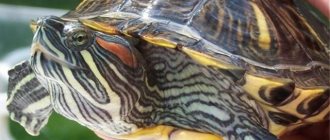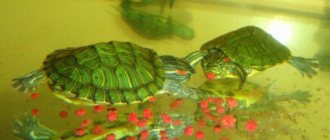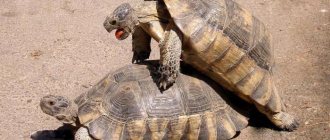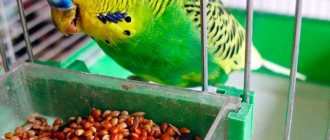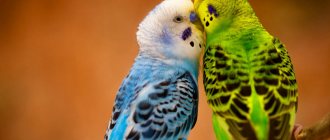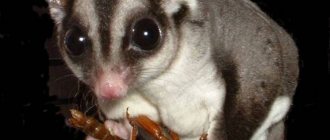02/10/2019Reptiles0
It is necessary to feed a land turtle at home correctly; the diet must be complete and balanced. After all, high-quality food is the key to a long and healthy existence for a pet.
- 1 Food in natural habitat
- 2 Feeding characteristics of species 2.1 Omnivores
- 2.2 Herbivores
Food in natural habitat
In the wild, land turtles obtain their own food. This is, for the most part, plant food - grass, plant roots, berries, algae from the edges of reservoirs. Some part of the diet of wild turtles is protein food. These are worms, small insects, small snails.
The peculiarity of this reptile is that it can remain without food for quite a long time, storing significant reserves of it in its body during favorable seasons.
These animals are well versed in what vitamins, micro- and macroelements they lack at a certain stage of life and successfully find the products they need in the animal and plant world.
What to feed
In natural conditions, red-eared fish mainly feed on crustaceans, fry, small fish, as well as insects and snails. The reptile also needs plant food.
At home, it can be fed with various types of commercial food. It is important that your pet’s diet is varied, so you should add natural food to your diet. It is worth noting that this type of turtle needs to be fed with water, as they are not able to produce saliva on their own.
Feeding features of the species
All natural species of turtles are divided according to their feeding method into three large orders:
- predatory;
- herbivores;
- omnivores.
Each of them has their own list of food products necessary for a full-fledged existence. But among the land species of turtles there are no predators, so it is important to consider only the diet of herbivores and omnivores. When purchasing these pets, it is imperative to find out what type of food they belong to.
The omnivorous species that are suitable for keeping at home and most often found in the world are the Mediterranean, musk, flat and Balkan.
Mediterranean
musky
Balkan
Flat
Herbivores include star, Indian, Central Asian, Egyptian, serrated, red-headed, radiated, Galapagos.
Indian
Star-shaped
Galapagos
Radiant
Redhead
Serrated
Egyptian
Central Asian
Omnivores
Their diet must necessarily consist of live food, for example:
- mice and small rats;
- frog;
- snails;
- insects - tubifex, bloodworms, daphnia, beetles, caterpillars, worms;
- slugs;
- fish and seafood.
The plant part of the diet should contain:
- vegetables;
- fruits;
- berries;
- aquatic plants;
- various herbs.
Herbivores
80% of the diet of these land turtles should be products of plant origin - various salads and spinach (leafy part), dandelion, cabbage.
Additional food:
- vegetable crops - pieces of carrots, cucumbers, zucchini, tomatoes, sweet peppers;
- fruits - apples, pears, peaches, apricots, bananas, citrus fruits;
- berries - cherries, raspberries, strawberries, grapes, currants, watermelon;
- other herbs - coltsfoot, sorrel, plantain, alfalfa, legumes;
- mushroom crops, such as champignons;
- special prepared food;
- bran and flakes from plant crops, sunflower seeds.
We recommend reading the article on what to feed pet turtles.
Home Diet Basics
At home, a land turtle does not have the opportunity to independently choose food, obtaining those products that its body needs at a particular moment. In addition, natural instincts are gradually dulled, which is manifested, for example, by the fact that it begins to absorb earth and small stones. Therefore, the owner of the reptile is responsible for the correct and balanced diet of the pet.
In order to prevent imbalances in nutrition, which can cause various diseases, it is recommended to keep a weekly diary of your pet’s nutrition. It creates a daily menu with the correct distribution of doses of vitamin supplements, calcium and amino acids.
The most correct diet would be the following ratio of products:
- herbs, greens - up to 75-80%;
- vegetable and fruit crops, berries - 10-15%;
- cereals, seeds, bread - up to 5%;
- vitamin supplements, micro- and macroelements, animal proteins, amino acids - up to 5%.
As herbs, the greatest preference should be given to the following plant crops:
- dandelion and lettuce (leaves);
- beans, peas, beans (stems and leaves);
- alfalfa;
- plantain;
- clover;
- parsley;
- aloe;
- lawn forbs;
- thistle;
- sorrel;
- sprouted wheat and oat sprouts;
- some flowering plants.
All types of land reptiles love vegetables:
- pumpkin pieces;
- fresh chopped carrots;
- small leaves of young cabbage;
- mature chopped zucchini, squash, cucumbers;
- radishes and beets - only in young fresh form.
It is advisable to give your pet pieces of apples or pears every day, and occasionally watermelon, strawberries, strawberries, raspberries, currants, peaches, and apricots.
All stone fruits are cored and the products themselves are cut or torn into small pieces.
As a protein component, you can give both worms, insects, snails, and small pieces of boiled or raw meat.
An approximate menu for the day might look like this (in grams):
- sprouted sprouts (for example, wheat) - 50;
- raw young beets, chopped - 30;
- chopped white cabbage leaves - 30;
- chopped boiled potato tubers - 30;
- raw minced beef or chicken or earthworms - 5-10;
- pieces of wheat bread - 25;
- fish oil, vitamins, microelements - 1-3.
It is necessary to give foods containing calcium a couple of times a week. For example, cottage cheese mixtures, cereal porridges - buckwheat, milk semolina or oatmeal.
At least once a week, the diet includes small quantities of seaweed, various bran, sunflower seeds, yeast, soybeans, mushrooms, and ready-made nutritional mixtures.
Would you like a drink, turtle?
Let your landlubber friend splash in the water sometimes.
Turtles of land species, as a rule, can obtain a sufficient amount of moisture from green and fruit and vegetable food. It is also known that these animals have the ability to absorb water through their skin. It is enough to satisfy the turtle's need for water during its 10-minute stay in the bathing suit.
You can ensure your pet is hydrated by bathing it daily. To do this, water is poured into the bath so that it covers only half of the turtle’s body. The head should remain above the water.
As for aquatic species, this is all a matter of course for them.
Like any living organism, turtles - whether a land herbivore or a freshwater carnivore - need a complete and balanced diet. A person who wants to have this reptile as a pet must approach this issue very responsibly.
Many people think that a turtle is an unpretentious animal; give it a cabbage leaf, and that’s enough. To avoid dramatic mistakes, you need to thoroughly familiarize yourself with the rules and diet of this reptile.
Do land turtles need water?
These reptiles, like other animals, require water for normal functioning. In nature, they get it from the stems and roots of plants, and also drink it when swimming in ponds.
There is no need to install special drinking bowls for a domestic reptile, but regular bathing should be organized. For some species, weekly water procedures are needed, for others it is enough to carry them out once a month. But it is still optimal to bathe pets once a week, and even more often in the hot season.
It is enough to pour warm water into a small container, not lower than +25 °C, and lower the pet there so that the liquid covers the entire upper shell and reaches at least the middle of the neck.
How to deal with dehydration
When turtles become dehydrated it can damage their kidney function quite dramatically and if this is the case then you need to seek veterinary advice as soon as possible. The correct treatment must be administered to ensure that the turtle rehydrates quickly and effectively.
Your veterinarian may advise force-feeding your pet, especially if dehydration has eventually led to anorexia, vision damage, or in cases where the sickly turtle will not or cannot feed itself. Luckily, turtles are quite easy to feed as they don't find it as distressing as other animals. This makes the procedure easier without the risk of harming the animal or yourself. There are three ways to force feed turtles which are listed below:
When it comes to hand feeding, this generally entails encouraging your turtle to eat as usual.
Syringe feeding, on the other hand, sees owners having to carefully syringe the selected food out of the turtle's throat. Finally, gastric feeding, where semi-liquid food is gently introduced directly into the animal's digestive system
This is done using a tube that is passed down the turtle's throat. However, this is a procedure that should be performed by a qualified veterinarian or veterinary nurse and should not be performed by anyone who does not know because if you get it wrong you could seriously harm your pet.
Food in summer and winter
Summer feeding of land turtles is usually not difficult, because fresh herbs, vegetables, fruits, and berries can be easily picked or purchased.
Food should be prepared for the winter. Greens can be cut and frozen in the refrigerator, dividing them into daily portions. You can do the same with fruits and vegetables. Forbs can also be prepared in the form of hay.
If there are fish in the house, then you can plant an abundance of aquatic plants in the aquarium and feed your land pet with them in winter.
In the terrarium you can also install clay pots in which alfalfa, oats, wheat stalks, plantain, dandelion sprouts, and cultivated varieties of greens grow. All types of land turtles happily eat sprouted carrot tops.
Consequences
If a turtle is fed too often and if protein foods predominate in the diet, then the turtle’s body grows faster than its shell and slowly “bursts” it from the inside.
- Wide growth lines appear on the shell (the carapace is a different color and width than in natural turtles)
- The carapace (upper part of the shell) begins to bulge
- Protruding groins and armpits
A typical overfed Central Asian turtle at home with an incorrect diet resembles a pie or a hamburger. This is one of the reasons why natural turtles look so different from those turtles that live at home.
The turtle knows no limits and loves protein foods, since this is a huge rarity in the desert. But a reptile cannot rebuild its metabolism and body to suit an inept owner. The photographs show the result of such “care” in the form of overfeeding. Some photos also show rickets, but this is a separate topic.
Mr. Tail explains: foods prohibited for land turtles
The owner of these reptiles should be well aware of the foods that should never be given to pets:
- stone fruit seeds - apricots, peaches;
- citrus peel;
- plants that are poisonous and medicinal, such as buttercup, nightshade, potato and tomato tops, crocus, narcissus, milkweed, delphinium, hydrangea, mistletoe, dieffenbachia, azaleas, lilies, elodea;
- sausages and canned goods.
Porridge, baked goods, dairy products, eggs and eggshells, meat, onions, garlic, celery, spinach stems, radishes, and spicy herbs are allowed only in minimal quantities.
Feeding rules
It is advisable to eat at the same time every day, preferably in the morning.
When feeding turtles, you must follow simple rules:
- Up to a year of age they are fed every day, after two years they can be fed every other day.
- Food utensils should always be washed clean before each feeding.
- Portions should be made small, and excess should be removed from the terrarium so that it does not spoil.
- Try to ensure complete rest for your pet while feeding. The turtle is frightened by loud sounds and sudden movements.
- Reptiles should not be taught to eat from their hands. They very quickly get used to this method of feeding, and then refuse to eat from the bowl.
- You should not overfeed your pets, that is, give food too often, this can lead to obesity and distortion of the carapace and plastron.
- Feeding too infrequently is also unacceptable, as this can cause exhaustion and death.
Errors
- Feed your reptile too often. This will cause overeating and indigestion.
- The reptile body is adapted to consume a certain type of food. You cannot feed a herbivore only meat, and a carnivore only fruits and vegetables.
- Giving your pet food too rarely. The individual will be weak, lethargic, inactive and susceptible to disease.
If you follow the rules of feeding land reptiles, they will have good health and longevity.
Most pet turtles have one common problem. The name of this problem is overfeeding
. In fact, the problem is no small one, since it is very important, to the extent of the turtle’s physiology, to feed it in moderation and in a balanced manner. A big mistake is how newbies treat turtles, believing that they need to be fed the same as other warm-blooded pets. You can't do that with turtles. It is very important to limit what they eat and this article will describe why.
